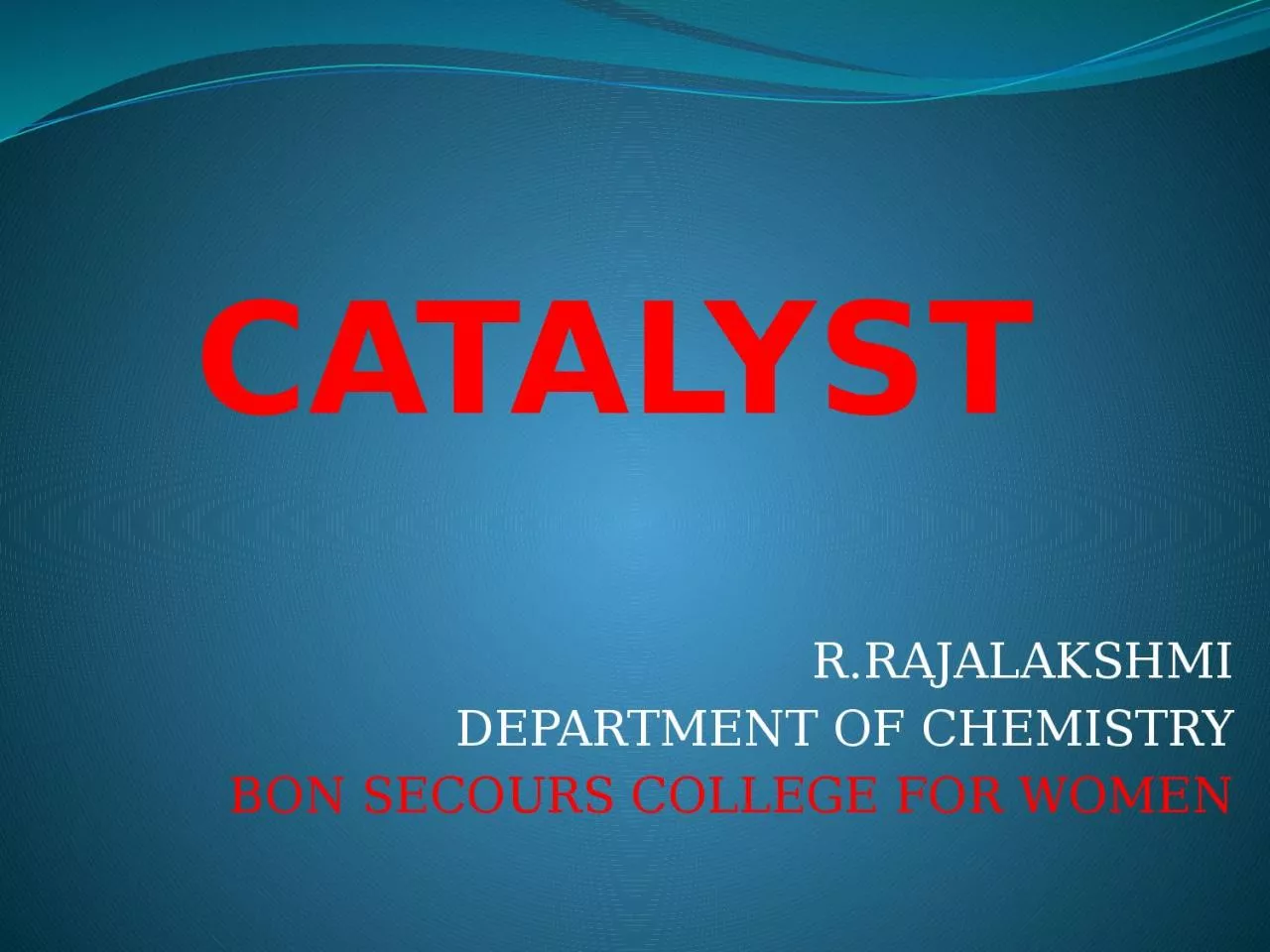

BON SECOURS COLLEGE FOR WOMEN Definition A catalyst is define as a substance which alters the rate of a chemical reaction itself remaining chemically unchanged at the end of the reaction This phenomenon is called catalysis ID: 920952
Download Presentation The PPT/PDF document "CATALYST R.RAJALAKSHMI DEPARTMENT OF CHE..." is the property of its rightful owner. Permission is granted to download and print the materials on this web site for personal, non-commercial use only, and to display it on your personal computer provided you do not modify the materials and that you retain all copyright notices contained in the materials. By downloading content from our website, you accept the terms of this agreement.
Slide1
CATALYST
R.RAJALAKSHMI
DEPARTMENT OF CHEMISTRY
BON SECOURS COLLEGE FOR WOMEN
Slide2Definition:
A catalyst is define as a substance which alters the rate of a chemical reaction, itself remaining chemically unchanged at the end of the reaction. This phenomenon is called catalysis.
EXAMPLE:In the above reaction, MnO2 acts as a catalyst.
Slide3Types of catalyst
Positive catalyst
:
A catalyst which enhance the rate of a reaction is called positive catalyst and the phenomenon is known as positive catalysis.Negative catalyst: A catalyst which retards the rate of a reaction is called negative catalyst and the phenomenon is known as negative catalysis.
Slide4Auto catalyst:
One of the products formed during the reaction acts as a catalyst for that reaction. Such type of catalyst is called auto catalyst and this phenomenon is known as auto catalyst.
Induced catalyst
: When one reactant influences the rate of other reaction, which does not occur under ordinary conditions, this phenomenon is known as induced catalyst.
Slide5Types of catalysis
Catalytic reactions are classified into two broad types:
a)Homogeneous catalysis
b)Heterogeneous catalysis And also there is a third types of catalysis known ENZYME CATALYSIS-BIOLOGICAL INTEREST.
Slide6Homogeneous cataly
sis
Definition:
The catalysis is in the same phase as the reactant and is evenly distributed throughout. This type occur in gas phase or the liquid phase.
Slide7Examples for homogeneous catalysis
Homogeneous catalysis in gaseous phase:
Oxidation of SO2 2SO2
+O
2
+[NO]-----------> 2SO
3
+[NO]
Homogeneous catalysis in solution phase:
Many reaction in solution are catalyst by acid and base ( H+ and OH_)
Hydrolysis of an ester in presence of acid or alkali.
CH
3
COOC
2
H
5
+H
2
O------------
CH
3
COO
H
+C
2
H
5
OH
Slide8Heterogeneous catalysis
The catalytic process in which the reactants and catalyst are in different phases is known as Heterogeneous catalysis.
The most important which the reactants are in the gas phase while the catalyst is a solid.
The process is also called CONTACT CATALYST.
Slide9Examples of heterogeneous catalysis
Heterogeneous catalysis in gaseous phase:
Combination of sulphur dioxide SO
2 and O2 in the presence of finely divided platinum or V2O5
(contact process of sulphuric acid).
2SO
2
+O
2
+[Pt]---
2SO
3
+[Pt]
Heterogeneous catalysis in solution phase:
The decomposition of aqueous solution so hydrogen peroxide(H
2
O
2
) is catalyzed by MnO
2
or Pt in colloidal form.
2H2O
2
+[Pt]----------
2H
2
O+O
2
+[Pt]
Slide10CHARACTERISTICS of CATALYTIC REACTION
A catalyst remains unchanged in mass and in chemical composition at the end of the reaction.
A small quantity of catalyst of catalyst is generally needed to produce almost unlimited reaction.
A catalyst is more effective when finely divided.
A catalyst is specific in its action.
The function of a catalyst is only to alter the speed of the reaction which is already occurring at a particular rate.
Slide11A catalyst cannot initiate a reaction.
A catalyst does not affect the final position of equilibrium, although it shortens the time required to establish the equilibrium.
Change of temperature alters the rate of a catalytic as it would do for the same reaction without catalyst (increase a temperature their catalytic activity decreased- coagulation occur).
The rate of reaction is maximum at a particular temperature called the optimum temperature.
Slide12Theories of catalysis
There are two main theories to explain catalysis:
a.)intermediate compound formation
b.)adsorption theory.The intermediate compound formation theory applies to homogeneous catalytic reactions.The adsorption theory applies to heterogeneous catalytic reactions.
Slide13Intermediate compound formation theory
The catalyst first forms an intermediate compound with one of the reactants.
The compound is formed with less energy consumption than needed for the actual reaction.
The intermediate compound being unstable combines with other reactant to form the desired product and the catalyst is generated.
Slide14example
The catalytic oxidation of SO2 to SO3 in the lead chamber process probably takes place as;
2NO + O2 2NO2
(Catalyst) (intermediate compound) NO2 + SO2 SO3 + NO (Product) (catalyst)
Slide15Adsorption theory
Adsorption theory explains the mechanisms of heterogeneous catalysis.
The catalyst functions by adsorption of the reacting molecules on its surface.
Slide16There are four steps involved in the heterogeneous catalysis:
Step-1: adsorption of reactant complex
The reactant molecules A and B strike the surface of the catalyst. They are held up at the surface by weak vanderwaal’s forces or by partial chemical bonds.
Step-2: formation of activated complexThe particles of the reactants adjacent to one another join to form an intermediate complex (A-B). The activated complex is unstable.
Step-3: decomposition of activated complex
The activated complex breaks to form the products C and D. the separated particles of the products hold to the catalyst surface by partial chemical bonds.
Step-4: desorption of products
The particles of the products are desorbed or released from the surface.
Slide17Thank you